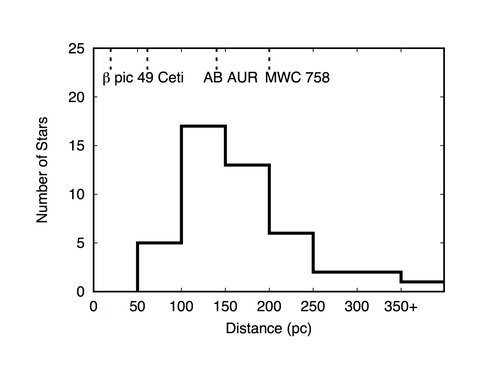2015 Annual Science Report
 NASA Goddard Space Flight Center
Reporting | JAN 2015 – DEC 2015
NASA Goddard Space Flight Center
Reporting | JAN 2015 – DEC 2015
Circumstellar Debris and Planetesimals in Exoplanetary Systems
Project Summary
GCA astronomer Marc Kuchner studies the dynamics of debris disks, extrasolar analogs to the Kuiper Belt and the asteroid belt in our solar system, using NASA’s supercomputers. He develops numerical models of the orbits and the interactions of the planetesimals in these disks for use in interpreting images of them made with the Hubble Telescope and other NASA observatories. Together, the images and models teach us about how planetary systems form and evolve – the context within which processes affecting our Solar System are evaluated and extended to exo-planetary systems. An important goal is to extend these studies to a wider range of proto-planetary systems, thereby expanding the range of diversity within which the Solar System must be interpreted. Kuchner’s second initiative targets that objective.
Accordingly, Kuchner invited the public to help him discover new planetary systems through a new website, launched in 2014. At DiskDetective.org, volunteers view data from NASA’s Wide-field Infrared Survey Explorer (WISE) mission and three other surveys. WISE measured more than 745 million objects, representing the most comprehensive survey of the sky at mid-infrared wavelengths ever taken. Among these objects, thousands of planetary systems await discovery – recognizable by the dusty disks that surround them. But galaxies, interstellar dust clouds and asteroids also glow in the infrared, which stymies automated efforts to identify these disks. At Disk Detective.org, the volunteers find the disks by watching 10-second videos of objects seen by WISE, then classifying them by clicking on a selection of buttons on their screens.
Project Progress
The Disk Detective project is now 27% complete. It has identified more than 3000 objects of interest, and is preparing its first paper for publication with a list of 39 new disk candidates. Kuchner led several new initiatives to follow up the best targets from the project: observing programs on the Tillinghast telescope at Whipple Observatory, ROBO-AO at Mt. Palomar, the duPont telescope, CASLEO Observatory, the James Clerk Maxwell Telescope, Gemini Planet Imager, and SOFIA.
Kuchner’s disk modeling efforts resulted in some interesting new results as well. It is widely known that debris rings often shine brighter on the side nearest the star they orbit, a phenomenon called “pericenter glow”. Kuchner’s team discovered that at long wavelengths, this effect is reversed. So for example, recent ALMA images of the debris ring around Fomalhaut should be reinterpreted as showing “apocenter glow”.
Publications
- Biller, B. A., Liu, M. C., Rice, K., Wahhaj, Z., Nielsen, E., Hayward, T., … Toomey, D. W. (2015). The Gemini NICI Planet-Finding Campaign: asymmetries in the HD 141569 disc. Monthly Notices of the Royal Astronomical Society, 450(4), 4446–4457. doi:10.1093/mnras/stv870
- Currie, T., Cloutier, R., Brittain, S., Grady, C., Burrows, A., Muto, T., … Kuchner, M. J. (2015). Resolving the HD 100546 Protoplanetary system with the Gemini Planet Imager: Evidence for multiple forming and accreting Planets. The Astrophysical Journal, 814(2), L27.doi:10.1088/2041-8205/814/2/l27
- Currie, T., Lisse, C. M., Kuchner, M., Madhusudhan, N., Kenyon, S. J., Thalmann, C., … Debes, J. (2015). Direct imaging and spectroscopy of a Young Extrasolar Kuiper Belt in the nearest OB Association. The Astrophysical Journal, 807(1), L7. doi:10.1088/2041-8205/807/1/l7
- Jang-Condell, H., Chen, C. H., Mittal, T., Manoj, P., Watson, D., Lisse, C. M., … Kuchner, M. (2015). Spitzer IRS spectra of Debris Disks in the Scorpius-Centaurus OB Association. The Astrophysical Journal, 808(2), 167. doi:10.1088/0004-637x/808/2/167
- Nesvold, E. R., & Kuchner, M. J. (2015). A SMACK model of colliding planetesimals in the β Pictoris debris disk. The Astrophysical Journal, 815(1), 61. doi:10.1088/0004-637x/815/1/61
-
PROJECT INVESTIGATORS:
-
PROJECT MEMBERS:
Erika Nesvold
Collaborator
Margaret Pan
Collaborator
Hanno Rein
Collaborator
Steven Silverberg
Collaborator
-
RELATED OBJECTIVES:
Objective 1.1
Formation and evolution of habitable planets.
Objective 1.2
Indirect and direct astronomical observations of extrasolar habitable planets.

